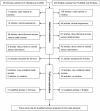Left radial access is preferable to right radial access for the diagnostic or interventional coronary procedures: a meta-analysis involving 22 randomized clinical trials and 10287 patients
- PMID: 24223815
- PMCID: PMC3818350
- DOI: 10.1371/journal.pone.0078499
Left radial access is preferable to right radial access for the diagnostic or interventional coronary procedures: a meta-analysis involving 22 randomized clinical trials and 10287 patients
Abstract
Objective: The transradial approach has been used extensively for both diagnostic and interventional coronary procedures; however, there is no universal consensus hitherto on the optimal choice of radial access from either the left or the right artery. We therefore sought to meta-analyze available randomized clinical trials to compare the left with the right radial access for the diagnostic or interventional coronary procedures.
Methods and results: Four electronic databases including the PubMed, EMBASE, Wanfang, and CNKI were searched up to April 2013. In total, there were 22 qualified randomized trials involving 5317 and 4970 patients assigned to the left and the right radial accesses, respectively. Data were extracted independently by two investigators. Analyses of the full data set indicated significant reductions in fluoroscopy time (seconds) (weighted mean difference; 95% confidence interval; P: -36.18; -53.28 to -18.53; <0.0005) and contrast use (mL) (-2.88; -5.41 to -0.34; 0.026) in patients with the left radial access compared to those with the right radial access, and there was strong evidence of heterogeneity but low probability of publication bias. The failure rate of radial access from the left was relatively lower than that from the right (odds ratio: 0.83; 95% confidence interval: 0.68-1.01; P = 0.064). Further in meta-regression analyses, body mass index was found to be a potential source of heterogeneity for both fluoroscopy time (regression coefficient: 35.85; P = 0.025) and catheter number (regression coefficient: 0.35; P = 0.018).
Conclusions: Our findings demonstrate that left radial access is preferable to right radial access in terms of fluoroscopy time and contrast use for the diagnostic or interventional coronary procedures. The import of this study lies in its great shock to the concept of convenient radial access from the right artery.
Conflict of interest statement
Figures




References
-
- Dominici M, Diletti R, Milici C, Bock C, Placanica A, et al. (2013) Operator exposure to x-ray in left and right radial access during percutaneous coronary procedures: OPERA randomised study. Heart 99: 480–484. - PubMed
-
- Norgaz T, Gorgulu S, Dagdelen S (2012) A randomized study comparing the effectiveness of right and left radial approach for coronary angiography. Catheter Cardiovasc Interv 80: 260–264. - PubMed
-
- Biondi-Zoccai G, Sciahbasi A, Bodi V, Fernandez-Portales J, Kanei Y, et al. (2013) Right versus left radial artery access for coronary procedures: an international collaborative systematic review and meta-analysis including 5 randomized trials and 3210 patients. Int? J? Cardiol 166: 621–626. - PubMed
-
- Sciahbasi A, Romagnoli E, Burzotta F, Trani C, Sarandrea A, et al. (2011) Transradial approach (left vs right) and procedural times during percutaneous coronary procedures: TALENT study. Am Heart? J 161: 172–179. - PubMed
-
- Zhou Y, Jin X, Chen Q (2012) The clinical value of left radial artery appraoch in coronary artery angiography. Journal of Electrocardiology and Circulation 31: 427–429.
Publication types
MeSH terms
Substances
LinkOut - more resources
Full Text Sources
Other Literature Sources
Miscellaneous

